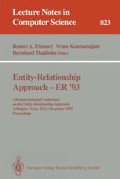Abstract
Two major problems in schema integration are to identify correspondences between different conceptual schemas and to verify that the proposed correspondences are consistent with the semantics of the schemas. This problem can only be effectively addressed if the conceptual schema is expressed in a semantically rich modelling formalism. We introduce such a modelling formalism, the distinguishing feature of which is the use of case grammar. We show that it is easier to identify correspondences between schemas expressed in this formalism than in schemas formulated in traditional modelling languages. The main reason for this is that case grammar standardizes the terminology in conceptual schemas by providing a set of meaningful and established labels for conceptual relations.
Preview
Unable to display preview. Download preview PDF.
References
C. Batini, M. Lenzerini and S. B. Navathe, “A Comparative Analysis of Methodologies for Database Schema Integration”. ACM Computing Surveys, vol. 18, no. 4, pp. 323–364, 1986.
C. Beeri, “Formal Models for Object Oriented Databases”, in First International Conference on Deductive and Object Oriented Databases, Ed. W. Kim, pp. 405–430, Kyoto, North-Holland, 1989.
J. Biskup and B. Convent, “A Formal View Integration Method”, in International Conference on the Management of Data, Ed. pp. Washington, ACM, 1986.
M. Bouzeghoub and I. Comyn-Wattian, “View Integration by Semantic Unification and Transformation of Data Structures”, in Ninth International Conference on Entity-Relationship Approach, Ed. H. Kangassalo, pp. 413–430, Lausanne, North-Holland, 1990.
W. Bright and A. Hurson, “A Taxonomy and Curent Issues in Multidatabase Systems”, IEEE Computer, vol. 24, no. 10, 199a
B. Bruce, “Case Systems for Natural Language”, Artificial Intelligence, vol. 6, pp. 327–360, 1975.
P. P. Chen, “The Entity-Relationship Model — Toward a Unified View of Data”, ACM Transactions on Database Systems, vol. 1 no. 1, pp. 9–36, 1976.
C. Collet, M. Huhns and W. Shen, “Resource Integration Using a Large Knowledge Base in Carnot”. IEEE Computer, pp. 55–62, December 1991.
B. Convent, “Unsolvable Problems Related to roe View Integration Approach”, in International Conference on Database Theory, Ed. pp. 141–156, Rome, 1986.
P. Creasy and B. Moulin, “Extending the Conceptual Graph Approach for Data Conceptual Modelling”, Data and Knowledge Engineering, vol. 8, no. 3, pp. 223–248, 1992.
R. ElMasri, J. Weeldryer and A. Hevner, “The Category Concept: An Extension to the Entity-Relationship Model”, Data and Knowledge Engineering, vol.1, no.1, 1985
H. Gallaire, J. Minker and J. M. Nicholas, “Logic and Databases: A Deductive Approach”, ACM Computing Surveys, vol. 16, no. 2, pp. 1984.
R. Guha and D. Lenat, “CYC: A Midterm Report”, Al Magazine, Fall 1990
M. Hammer and D. McLeod. “Database Description with SDM: A Semantic Database Model”, ACM Transactions on Database Systems, vol.6, no.3, pp. 351–386, 1981.
R. Hull and R. King, “Semantic Database Modeling: Survey, Applications and Research Issues”, ACM Computing Surveys, vol.19, no.3. pp. 201–260, 1987.
E. I. J. v. Griethuysen, “ISO — Concepts and Terminology for the Conceptual Schema and the Information Base”, N69S ISO/TC9/SC5/WG3, 1982.
P. Johannesson, “A Logic Based Approach to Schema Integration”, in 10th International Conference on Entity-Relationship Approach, Ed. T. Teorey, San Fransisco, North-Holland, 1991.
P. Johannesson, “A Logical Basis for Schema Integration”, in Third International Workshop on Research Issues in Data Engineering — Interoperability in Multidatabase Systems, Ed. H. Sehet Vienna, IEEE Press, 1993.
P. Johannesson, “Schema Transformations as an Aid in View Integration”, in 5th International Conference on Computer Aided Information Systems Engineering, Ed. C Rolland, Paris, Springer, 1993.
P. Johannesson, Schema Integration, Schema Translation, and Interoperability in Federated Information Systems, PhD thesis, Department of Computer and Systems Sciences, Stockholm University, 1993.
J. A. Larson, S. Navathe and R. ElMasri, “A Theory of Attribute Equivalence in Databases with Applications to Schema Integration”, IEEE Transactions on Software Engineering, vol. 15, no. 4, pp. 449–463, 1989.
J. Lloyd, Foundations of Logic Programming, Springer Verlag, 1987.
A. Motro, “Superviews: Virtual Integration of Multiple Databases”, IEEE Transactions on Software Engineering, vol. 13, no. 7 pp. 785–798, 1987.
G. Nijssen and T. Halpin, Conceptual Schema and Relational Databau Design, Prentice-Hall 1989.
J. Peckham and F. Maryanski, “Semantic Data Modeb”, ACM Computing Surveys, vol. 20, no.3. pp. 153–190, 1988.
A. P. Sheth and J. A. Larson, “Federated Database Systems for Managing Distributed, Heterogeneous, and Autonomous Dstabases”. ACM Computing Surveys, vol. 22, no, 3, pp. 183–236 1990.
W. W. Song, P. Johannesson and J. A. Bubenko Jr, “Semantic Similarity Relations in Schema Integration”, in 11th International Conference on the Entity-Relationship Approach, Ed. A. M. Tjoa, Karlsruhe, Germany, 1992.
J. F. Sowa, Conceptual Structures — Information Processing in Mind and Machine, Addison-Wesley, 1984.
S. Spaccapietra, C. Parent and Y. Dupont, “Model Independent Assertions for Integration of Heterogeneous Schemas”, The VLDB Journal, vol. 1. no. 2, pp. 81–126, 1992.
Author information
Authors and Affiliations
Editor information
Rights and permissions
Copyright information
© 1994 Springer-Verlag Berlin Heidelberg
About this paper
Cite this paper
Johannesson, P. (1994). Using conceptual graph theory to support schema integration. In: Elmasri, R.A., Kouramajian, V., Thalheim, B. (eds) Entity-Relationship Approach — ER '93. ER 1993. Lecture Notes in Computer Science, vol 823. Springer, Berlin, Heidelberg. https://doi.org/10.1007/BFb0024374
Download citation
DOI: https://doi.org/10.1007/BFb0024374
Published:
Publisher Name: Springer, Berlin, Heidelberg
Print ISBN: 978-3-540-58217-5
Online ISBN: 978-3-540-48575-9
eBook Packages: Springer Book Archive

